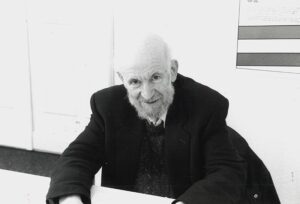Michaela Unterdörfer
in conversation with Michaela Melián
It is now 25 years ago that Gustav Metzger’s exhibition Ein Schnitt entlang der Zeit took place at Kunsthalle Nuremberg. The project was realised in collaboration with the Oxford Museum of Modern Art. The suggestion came from the curator Hans Ulrich Obrist, who had accompanied Metzger over many years and conducted several conversations with him. Obrist knew that Metzger originally came from Nuremberg. He approached the then-director of Kunsthalle Nürnberg, Ellen Seifermann, and proposed the collaboration with Oxford.
Gustav Metzger was already 73 years old when he came back to Nuremberg in 1999 for the first time since fleeing in 1939. It mattered to him very much that the exhibition in Nuremberg did not simply replicate the Oxford one. He developed the concept anew for the site. He had exhaustively engaged with the Kunsthalle before deciding which of his older works he wanted to display there and what new productions to elaborate in situ. It was from the first important to him to reestablish contact with the city in which he had spent his childhood.
 Gustav Metzger at the Kunsthalle Nürnberg during his exhibition Ein Schnitt entlang der Zeit, Nuremberg, 1999. Photo: Michaela Unterdörfer
Gustav Metzger at the Kunsthalle Nürnberg during his exhibition Ein Schnitt entlang der Zeit, Nuremberg, 1999. Photo: Michaela Unterdörfer
I was fascinated by the intensity he radiated and with which he set out. He initially came to Nuremberg for several weeks to prepare and install the exhibition, and then kept prolonging his visit after the opening. That was completely unheard of. Artists habitually depart after the opening of their exhibition – occasionally they might come back for a conversation. For him, however, the work was not finished with the opening. On the contrary, he took the exhibition as both a place and an opportunity to engage visitors into a conversation. He basically lived there – he spent his entire day in the Kunsthalle, continuing to work on the installations.
I don’t recall how long he ended up staying. We had rented a flat for him during the set up of the exhibition and then had to apply for more budget from the accounting to be able to prolong his rental contract. He frequently travelled to Munich, where he produced different works in the course of the exhibition Dreamcity, such as the action Travertin/Judenpech at Haus der Kunst and the installation of one of the Historic Photographs at Kunstverein München.
He was by no means an artist stuck in the past. He did not want to be perceived as a Jewish artist who had fled Nuremberg and whose family had been murdered in the Holocaust. His interest was with the present. In this, he was ahead of his time, with the topics he engaged with in his manifestos, actions, and works still at the forefront of our minds today. He was turned towards the world and the present. Naturally, his own history was a part of him, but it was not his primary theme. Nuremberg’s national-socialist past remained for him virulent, along with the innumerable conflicts in the world – the destructiveness, the cruelty of humans, which his work depicted and contextualised.
I don’t recall if he visited the Nazi Party Rally Grounds at the time. We went on walks through the city, for instance to Gostenhof. In his childhood, it had been a so-called ‘shattered glass district’ with a large Jewish population. We even went out to eat in Fürther Straße, the street in which his parental home had been. It had become something of a hip area and barely matched his childhood memories.
Gustav Metzger had no phone in the 1990s. One could only get a hold of him on public phones, such as those in London Underground stations. We thus had to schedule our phone calls. He would notify me of the number of the public phone and then wait there for a call back. In terms of planning for an exhibition, this was a little bit unusual, but it did work out because he was extremely reliable and determined. He certainly kept contact with a lot of people that way. Metzger was constantly on the go, his pockets and bags full of books, newspapers, and magazines. He spent his time primarily in cafés or museums. That was also were he took meetings. Only very few knew where he actually lived.
Michaela Unterdörfer, curator of the 1999 Nuremberg exhibition Ein Schnitt entlang der Zeit, in conversation with the artist Michaela Melián, 27th of June 2024